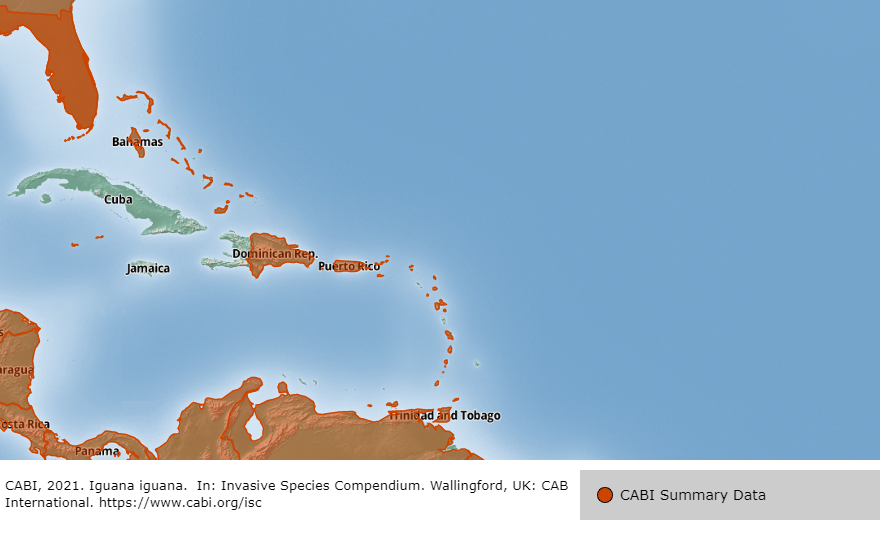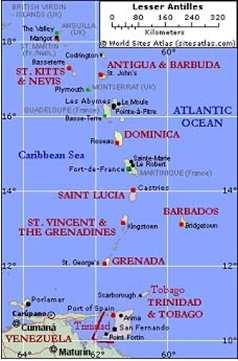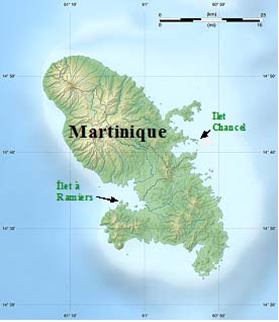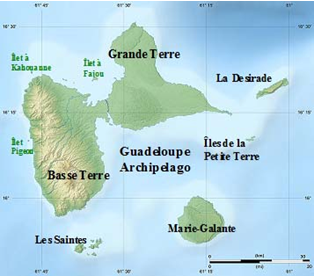The Invasive Green Iguana (Iguana iguana) is Threatening the Endangered Lesser Antillean Iguana (Iguana delicatissima): Brief Report of the Situation in the French West Indies
The Lesser Antillean Iguana (LAI) (Iguana delicatissima, Photo 1) is listed as “Endangered” on the IUCN Red List of threatened species (IUCN, 2010). This iguana species originating from the northern Lesser Antilles (islands, West Indies), historically ranged from Anguilla to Martinique (Fig. 1). It has now disappeared from several islands and is vulnerable on the others.
The main cause of its decline is habitat loss and fragmentation, but other threats include road causalities, illegal hunting, predation by feral and pet carnivores (cats, dogs, mongooses) and, to a lesser extent, by raccoon (Procyon lotor), and hybridization and competition with the invasive green iguana. Iguana iguana species is native to South America and Central America. It is more adaptable, and more aggressive than the LAI. Introduced in the Fort Saint-Louis in Fort de France by Father Pinchon in the 70’s, from the Saintes Islands. It seems that the green iguanas observed and captured in Martinique originate from this Fort St Louis’ population. The green iguana population is currently expanding to the detriment of the LAI population.
Within French West Indies, both species are present. Green Iguana progressively colonized the Guadeloupe archipelago and Martinique Island by human introduction, natural migration due to disproportionate increase of a particular population, this species being more opportunistic and adaptable. Private gardening provides adequate hatchling areas, and farming and dumping provide foraging areas that lead to population development and natural expansion.
Wherever both species share the same habitat, hybridization is common. Hybrid offspring has been found to be fertile, and the gene pool of Iguana delicatissima is now being diluted by the gene pool of green iguana.
It is now admitted by the international herpetological community that the green iguana is an invasive species that threatens the LAI (Breuil, 2002), but its status differs depending on the island considered:
In Martinique, there are 3 regions where genetically pure LAI can be found (Fig. 2):
Chancel Islet, which harbours the main population of Martinique. Most of the studies and capture sessions are undertaken on this island. It is free of green iguanas.
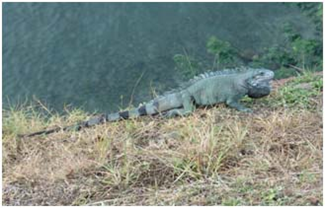
Green iguanas have been seen on the shore of Martinique main island, close to Chancel Islet in Le Robert. To date, there are no reports of green iguanas from other islets next to Chancel Islet, but absence of I. iguana should be confirmed via a thorough survey. The close proximity of Chancel Islet (and a few other islets) to Le Robert on the main island represents a significant risk factor for the pure LAI population on Chancel Islet. Should any green iguanas be detected during the survey, they would have to be removed.
Northern Martinique is inhabited by a population for which very little is known. The challenge for coming years will be to increase the number of visits made to that population to improve our knowledge of it.
Concerning the green iguana, it has been introduced in the Fort Saint-Louis in Fort de France by Father Pinchon in the 70ies, from the Saintes Islands. It seems that the green iguanas observed and captured in Martinique originate from this Fort St Louis’ population. Here the elimination of the green Iguana is allowed and recommended by the French national action plan.
Ramiers Islet where some individuals have been translocated from Chancel Population in order to increase the number of sites on which I. delicatissima gene pool can be preserved
In Guadeloupe archipelago (Fig. 3), the Petite Terre Reserve represents one of 2 biggest population of LAI (along with Dominica) of the Lesser Antilles, and is free of green iguanas. For individuals being easily spotted and observed, this population would also provide perfect research material.
On the main island of Guadeloupe, it is assumed that the genetically pure LAI population is lost. The green iguana population rapidly spread over Basse Terre and Grande Terre replacing the LAI population. However, a programme of genetic analysis and translocation is being conducted to identify the remaining genetically pure LAI individuals and move them on an island as done on Ramiers Island in Martinique. However, the risk of the green iguana from Basse Terre to invade the chosen islet has to be assessed.
Fig. 3. Map of Guadeloupe Archipelago
Some more individuals can be found on la Desirade Island, and on Marie-Galante Island, sharing it with green iguanas. On Les Saintes Islands, only hybrids and green iguanas have been found.
There, the green iguana is a protected species. Historically, the presence of this Guadeloupian population was considered as natural, and thus it has been decided to protect both species. Along with some factors mentioned formerly, this protected status allowed the green iguana to spread across Guadeloupe to the detriment of LAI (Breuil, 2002).
In Saint Martin, there are no more genetically pure individuals. Only hybrids and green iguanas can be found. It is therefore not worth to attempt the eradication of the green iguana for now.
In Saint Barthelemy Island, the status of LAI is similar to the one in Martinique. It is necessary to help the Iguana Delicatissima Saint Barth (IDSB) group to preserve the remaining population from the invasion of green iguana.
A French National Action Plan was written, and validated in 2010. It defines 15 actions to be undertaken with three main objectives: to improve the knowledge on both species of iguana and their interactions, to actively protect the populations of Iguana delicatissima, and to promote LAI conservation to the public. The eradication of the green Iguana is allowed and recommended by the French national action plan.
References
M. Breuil, 2002. Histoire naturelle des Amphibiens et des Reptiles terrestres de l’archipel Guadeloupéen. Guadeloupe, Saint Martin, Saint Barthélemy. Paris MNHN, institut d’Ecologie et de gestion de la biodiversité, Service du patrimoine Naturel Patrimoines Naturels n°54, 339 p.
IUCN Red List of Threatened speciesTM; http://www.iucnredlist.org/apps/redlist/details/10800/0. Accessed on June 14, 2011.
Distribution Map (CABI ISC):
